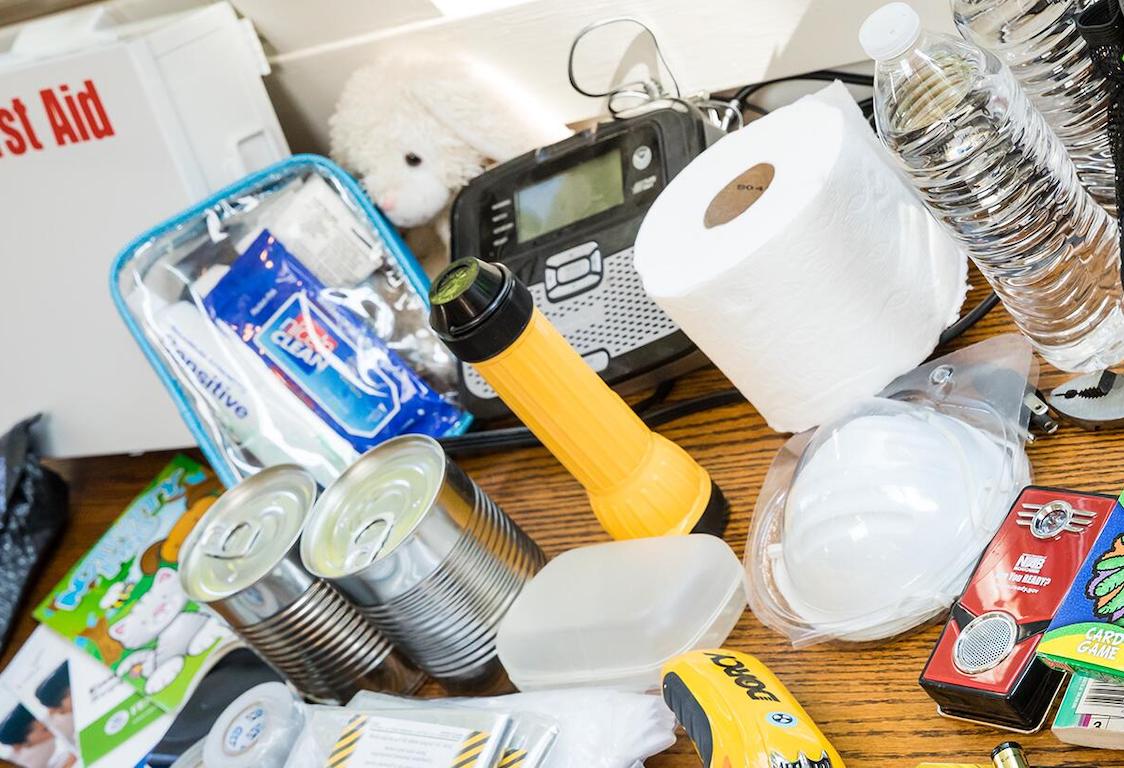The Essentials
- Water — one gallon (for drinking and sanitation) per person, per day, for at least three days. (This is for emergency evacuation purposes)
- Food — at least a three-day supply of nonperishable easy-to-prepare items.
- Blankets/sleeping bags/pillows/towels.
- Closed-toe, sturdy shoes.
- Gloves.
- Jacket or coat and rain poncho.
- Battery-powered or hand crank radio and a NOAA Weather Radio with tone alert
- Flashlight. (Forehead light recommended so hands are free)
- Extra batteries.
- Important documents — copies of insurance policies, identification, bank accounts, birth certificates, family communication contacts and emergency medical information — stored in a waterproof and portable container.
- Prescription medication.
- Extra cash.
- Dust masks (N95 if available) to help filter contaminated air.
- Plastic sheeting and duct tape to shelter in place.
- Moist towelettes, garbage bags and plastic ties (for personal sanitation)
- Whistle (to signal for help)
- Basic tools: wrench, pliers, multi-purpose tool and screwdriver (sufficient to turn off utilities).
- Manual can opener.
- Local maps.
- Cell phone chargers and backup battery.
- Sanitation (toilet paper, hand sanitizer) and personal hygiene (tooth brush) items and feminine supplies.
- Matches in a waterproof container
- Tube tent
- Cord & nylon string
- First aid kit.
- Two pairs of latex or other sterile gloves.
- Sterile dressings to stop bleeding.
- Soap and antibiotic towelettes.
- Antibiotic and burn ointments.
- Bandages in a variety of sizes.
- Eye wash solution.
- Thermometer.
- Aspirin, Tylenol and Ibuprofen or other pain reliever.
- Anti-diarrhea medication.
- Antacid.
- Laxative.
- Scissors and tweezers.
- Moleskin
- Prescription medications and medical supplies.
Optional items
- Cash
- Mess kits, paper cups, plates, paper towels and plastic utensils.
- Extra clothes that can be washed by hand and hang dry.
- Household chlorine bleach and medicine droppers.
- Books, games, puzzles or other activities for children.
- Baby supplies — bottles, formula, wipes, diaper rash cream and diapers.
- Medical supplies — oxygen, catheters, wheelchairs, hearing aid batteries, etc.
- Two-way radios.
- Rain gear.
- Glow sticks.
- Air horn
- Micron water filter
- Sleeping pad (pool flotation lounger w/pillow)
- Prescription eyeglasses and contact lens solution
- Small fire extinguisher
- Paper and pencil.
- Extra set of car and house keys
For your pet
- Photocopies of medical records and photos of your pets for identification purposes.
- Medications.
- Feeding dishes and at least a three-day supply of food and water.
- Disposable litter trays and litter.
- Extra collar or harness and leash.
- Blanket and toys.
- Sturdy pet carrier.
- Important information and the name and telephone number of your veterinarian.
Maintaining Your Kit
After assembling your kit remember to maintain it so it’s ready when needed:
- Keep canned food in a cool, dry place.
- Store boxed food in tightly closed plastic or metal containers.
- Replace expired items as needed.
- Re-think your needs every year and update your kit as your family’s needs change.
Kit Storage Locations
Since you do not know where you will be when an emergency occurs, prepare supplies for home, work and cars.
- Home: Keep this kit in a designated place and have it ready in case you have to leave your home quickly. Make sure all family members know where the kit is kept.
- Work: Be prepared to shelter at work for at least 24 hours. Your work kit should include food, water and other necessities like medicines, as well as comfortable walking shoes, stored in a “grab and go” case.
- Car: In case you are stranded, keep a kit of emergency supplies in your car.
